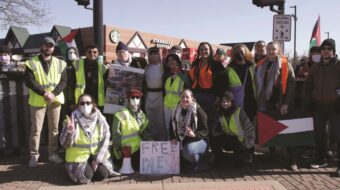The power struggle that erupted last week in northern Afghanistan illustrates the chaos ravaging the country two and a half years after U.S. troops invaded, ostensibly chasing Osama Bin Laden.
On April 8, the north’s dominant warlord, Gen. Abdul Rashid Dostum, drove a neighboring rival warlord and a provincial governor appointed by interim president Hamid Karzai out of Maimana, capital of Faryab province. This forced the U.S.-installed Karzai to send 750 soldiers from his newly formed Afghan National Army (ANA) to the area, together with their U.S. trainers.
Though Dostum’s forces left Maimana two days later, at last word they were still in control in Faryab province. In recent days Dostum also clashed with the militia of another rival, Ustad Atta
Mohammad, near Dostum’s stronghold, Mazar-e-Sharif. Though Dostum is nominally Karzai’s representative in the region, he was reluctant to accept the formation of a central government headed by Karzai, and remains a major rival.
In March, Ismail Khan, the west’s dominant warlord and the governor of Herat, drove a pro-government commander out of the province, forcing Karzai to send 1,000 ANA troops to the area.
Such clashes, combined with the ongoing attacks by the Taliban, Al-Qaeda and the forces of Gulbuddin Hekmatyar in eastern and southern Afghanistan, have forced the postponement of elections initially slated for June. In fact, many international observers consider most areas outside the capital city, Kabul, to be highly unstable. They liken the situation to the civil war that raged in the 1990s after the defeat of the national democratic People’s Democratic Party (PDPA) government of President Najibullah.
The United Nations has said that for the elections to be credible, at least 70 percent of the country’s 10.5 million eligible voters should be registered. But by early April only about 15 percent of this goal had been reached.
With national elections now rescheduled for September, the government said this week it will pursue its previously announced plan to disarm 40 percent of the estimated 100,000 fighters serving in private militias organized by warlords like Dostum and Khan.
“We believe that the main reason for the remaining problems is the presence of militias and the issue of warlordism,“ government spokesperson Jawed Ludin told journalists. But most commentators believe the government will pull its punches rather than risk too open a conflict.
The various warlord factions can trace their origins to the private mujahedin militias created and armed by the CIA during its long campaign against the PDPA government. Their leaders have spent the last two years rebuilding their holdings in competition with the central government. Dostum has an even more interesting history: he was once a key commander in Najibullah’s army, and many believe his defection to the mujahedin marked the turning point in the destruction of Afghanistan’s fledgling people’s government.
Another profoundly destabilizing factor is the dominance of the opium trade in Afghanistan’s economy. The opium poppies, which have long funded the warlords, Gulbuddin’s gang in eastern Afghanistan, the Taliban and probably Al-Qaeda, are in full bloom again. Last year the drug trade made up over half of the country’s national income, with the opium grown in 28 of the country’s 32 provinces making up 75 percent of the world’s production. Experts expect land under poppy cultivation to increase by 30 percent this year.
Karzai has warned that opium is “undermining the very existence of the Afghan state,” and has declared an all-out campaign against it. But many desperately poor small farmers turn to the crop because it pays far more than anything else they could grow. Again, in view of the pre-election political turmoil, the government is expected to pull its punches.
Last week The New York Times quoted Uganda-born political scientist Mahmood Mamdani, who says present-day terrorism originated in U.S. cold war foreign policy. After the Vietnam War, Mamdani contends, the U.S. shifted from direct intervention against the socialist world to supporting low-level insurgency by private militias.
“In practice,” Mamdani has written, “it translated into a United States decision to harness, or even to cultivate, terrorism in the struggle against regimes it considered pro-Soviet.” Noting that the best known CIA-trained terrorist is Osama Bin Laden, Mamdani added, “The real damage the CIA did was not the providing of arms and money, but the privatization of information about how to produce and spread violence – the formation of private militias – capable of creating terror.”
The author can be reached at mbechtel@pww.org.











Comments